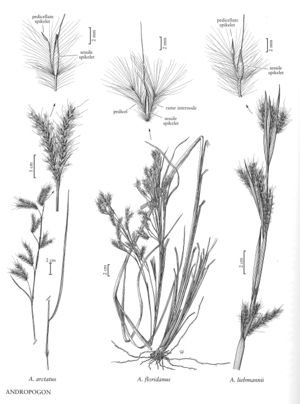Difference between revisions of "Andropogon floridanus"
imported>Volume Importer |
imported>Volume Importer |
||
| Line 43: | Line 43: | ||
|publication year= | |publication year= | ||
|special status=Endemic | |special status=Endemic | ||
| − | |source xml=https:// | + | |source xml=https://bitbucket.org/aafc-mbb/fna-data-curation/src/2e0870ddd59836b60bcf96646a41e87ea5a5943a/coarse_grained_fna_xml/V25/V25_1582.xml |
|subfamily=Poaceae subfam. Panicoideae | |subfamily=Poaceae subfam. Panicoideae | ||
|tribe=Poaceae tribe Andropogoneae | |tribe=Poaceae tribe Andropogoneae | ||
Revision as of 22:03, 5 November 2020
Plants cespitose, usually densely obpyramidal to oblanceolate above. Culms 70-210 cm; internodes occasionally somewhat glaucous just below the node; branches straight, mostly erect to ascending. Sheaths often scabrous, somteimes smooth; ligules 0.4-1.2 mm, ciliate, cilia 0.2-1.3 mm; blades 32-61 cm long, 2.9-5 mm wide, glabrous, rarely sparsely pubescent. Inflorescence units (9)50-210 per culm; subtending sheaths (3)4-5.9(7) cm long, (1.5)2-2.7(3.6) mm wide; peduncles (10)19-48(93) mm, with 2(4) rames; rames (2)2.5-3.7(4.5) cm, usually exserted at maturity, internodes evenly pubescent. Sessile spikelets (3.8)4.4-4.8(5.5) mm; callus hairs 1-3 mm; keels of lower glumes glabrous below midlength; awns 5-15 mm; anthers 1(3), 1.3-2 mm, usually yellow (sometimes purple). Pedicellate spikelets vestigial or absent. 2n = 20.
Distribution
Fla., Ala., Ga.
Discussion
Andropogon floridanus grows on sandy soils in southeastern Georgia and Florida, being most abundant in Pinus clausa scrublands. It usually occurs in small stands, but stands of about a hundred individuals have been observed.
Selected References
None.
